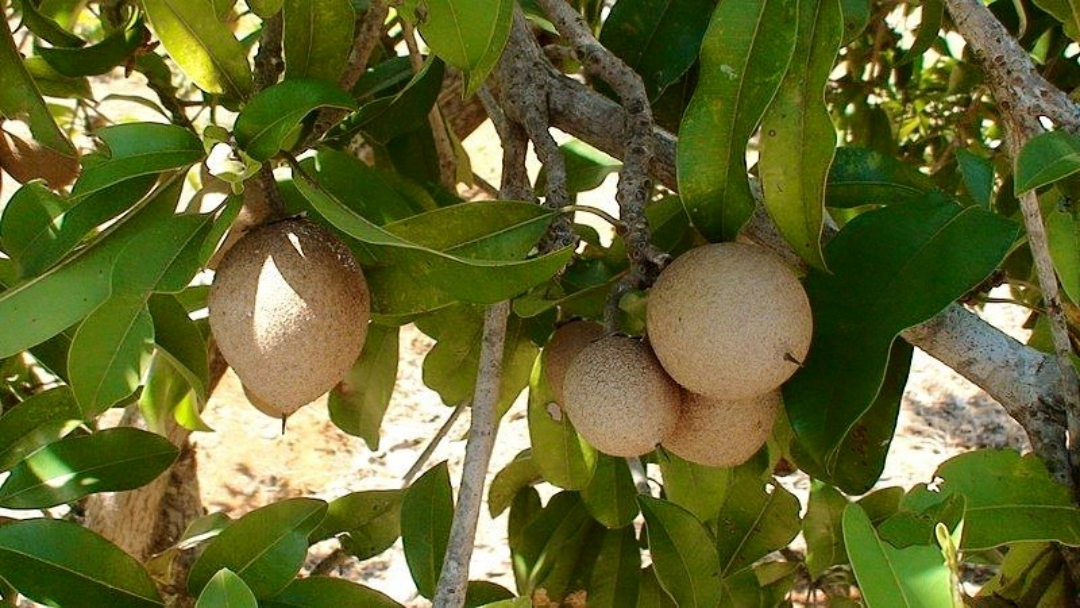
The shape of a ciku is rather ovoid, and is about the size of a chicken’s egg. — Photo courtesy of Sahabat Agrotech
THERE are quite a number of local fruits that were once popular and grown in many home gardens years back, but now, they are nowhere to be seen – not even in the outskirts of the major towns in Sarawak.
This makes me wonder about why those from the new generation no longer plant and keep them in the garden nowadays.
‘Sapodilla’ – or ‘ciku’, as many of us call it – is a popular tropical fruit belonging to the Sapotaceae family, of which the tree has thick, heavy canopy that can provide ample shade over the space where it is planted.
Just recently, I pruned and pollarded a fully-grown, 20-foot high ciku tree in my garden – it’s not an easy tree to grow.
The sapodilla is native to Central America and also the northern part of South America. Owing to the long viability of its dry seeds, this tree producing such a delicious fruit is now well distributed throughout the tropics. It grows best in deep-drained soil, though it can thrive in a variety of soil types and climates.
Botanically, it is an attractive evergreen tree that looks pyramidal when young, but becomes ‘rounder’ as it matures. The tree could grow up to a height of 25m, with the branches reaching wider radius.
The tree exudes sticky white latex from the bark of any part on it, and also from the unripe fruits. Back in the days, this latex was tapped and used as the base for chewing gum.
The leaves are unifoliate, each about 15cm long and 5cm wide. The flowers are small and white, and they sprout from the axils of leaves toward the shoot terminals.
The fruit is rather ovoid, and about the size of a chicken’s egg too. The brown, scurfy skin is not attractive at all, but it does conceal a yellowish brown flesh, which has a sugary taste and a velvety texture. Enclosed in the flesh are few shiny black seeds, not unlike those inside a ‘durian belanda’ (soursop).
Unripe fruits have saponin, which helps soften them as they ripen. Traditionally, unripe ciku would be ‘buried’ in rice grains until it turns soft.
Health benefits

The brown, scurfy skin of the ciku conceals a yellowish brown flesh, which has a sugary taste and a velvety texture. — Photo courtesy of Sahabat Agrotech
Sapodilla is a high-calorie fruit, but is low in fat and has no cholesterol content.
The pulpy characteristic of the fruit indicates its high fibre content, which can help improve bowel movements and also address other digestive ailments such diarrhoea, heartburn and gastritis. It can also help enhance the immune system, protecting it against harmful bacteria and other microorganisms.
Ciku has Vitamin A, know to help improve vision, reduce the effects of ageing, maintain blood pressure and keep a healthy heart.
Other nutrients include Vitamin C, niacin, riboflavin and thiamine, with good amounts of iron, copper and calcium.
Cultivation
The source of this fruit seems to have been spread by the early voyagers, who carried the seeds from the rainforests of Central America to the East such as the Philippines and further down to Malaysia, India and Sri Lanka, with the aim of growing them as a commercial crop. Seed propagation appears to be the main cultivation means, but for large-scale commercial production, grafting and budding methods are used.
Graft wood is selected from mature terminal shoots on which the bark is just turning brown.
The wood is pre-treated by cincturing or defoliation. The grafting or budding process needs to be performed quickly because the latex does ooze out rather quickly, and able to mess up ‘the operation’.
Grafting can speed up the juvenile period of growth a few years before maturity. Interestingly, a ciku tree can withstand salinity and is tolerant to drought conditions.
It is also resistant to pests, so it needs not much pruning or pest-control.
Assistance required for growth would include using NPK fertiliser in the ratio of eight per cent nitrogen, 2.4 per cent phosphoric acid and eight per cent potash for up to about half kilogramme per tree – once every three months until it matures.
By the time the tree begins to flower and bear fruits, it is already tall, with bushy foliage consisting of dark green leaves. It is usually a favourite site for some garden birds to roost and build nests upon.
The only problem is the difficulty in spotting the fruits amidst the thick foliage, as they are mainly borne out from the terminal shoots.
Sometimes, I would just wait for the fruits to drop as they begin to ripe.
That’s a really happy time for us to enjoy the fruit of our cultivation with our loved ones.
Happy gardening!
